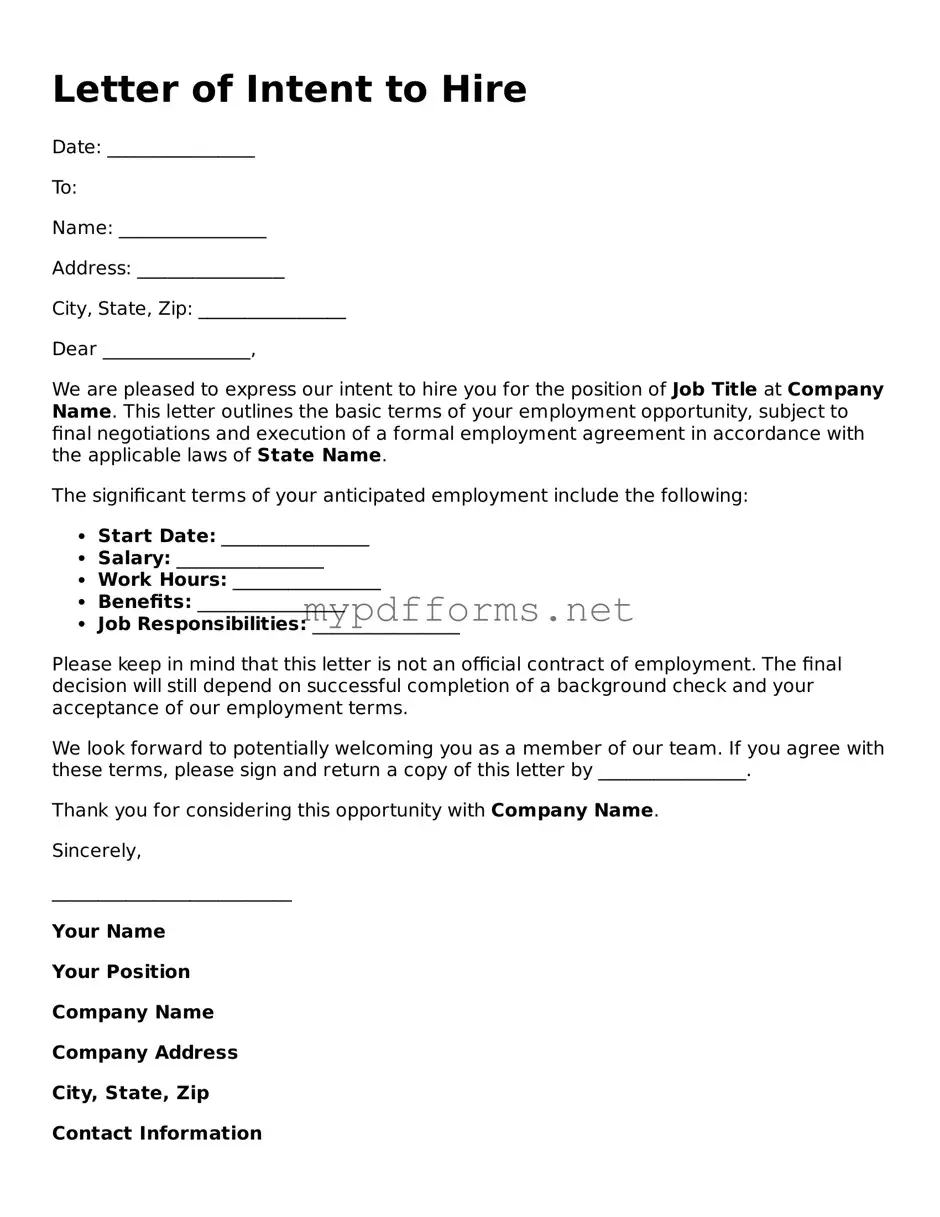The Letter of Intent (LOI) is often compared to a Memorandum of Understanding (MOU). Both documents serve as preliminary agreements between parties, outlining the intentions and expectations prior to a formal contract. An MOU typically details the scope of collaboration, responsibilities, and timelines, similar to how a Letter of Intent may specify the terms of employment or engagement. While an LOI may focus more on the hiring process, an MOU can encompass a broader range of collaborative efforts.
Another document akin to the Letter of Intent to Hire is the Employment Agreement. This formal contract delineates the terms of employment, including salary, benefits, and job responsibilities. Unlike the LOI, which expresses intent without binding legal obligations, an Employment Agreement is legally enforceable. However, both documents initiate a professional relationship and outline key terms that will be further detailed in the final contract.
The Offer Letter is also similar to the Letter of Intent to Hire. An Offer Letter is typically a more formalized document that extends a job offer to a candidate. It includes specific details such as job title, start date, and compensation. While the LOI may express a general interest in hiring, the Offer Letter serves as a definitive proposal that the candidate can accept or decline, thus moving the hiring process forward.
A Non-Disclosure Agreement (NDA) shares similarities with the Letter of Intent in that both documents are often used during the preliminary stages of employment discussions. An NDA protects confidential information shared between parties, ensuring that sensitive details remain private. While the LOI focuses on the intent to hire, an NDA secures the information exchanged during negotiations, which can be crucial for both parties.
The Letter of Understanding (LOU) is another document that parallels the Letter of Intent to Hire. An LOU outlines the mutual understanding between parties regarding specific terms and conditions. Similar to an LOI, it serves as a foundation for future agreements, but it often includes more detailed expectations and responsibilities, making it a useful tool for clarifying intentions before formalizing a contract.
Understanding the process for submitting a Tennessee Homeschool Letter of Intent form is crucial for parents who wish to provide a homeschooling education for their children. This document plays a significant role in notifying local authorities of educational intentions and ensuring that families meet the necessary state requirements.
In some cases, a Term Sheet can be compared to the Letter of Intent to Hire. A Term Sheet summarizes the main points of a potential agreement, laying out the essential terms and conditions that will be addressed in a more detailed contract later. While the LOI expresses intent to hire, the Term Sheet can outline various aspects of the employment arrangement, including compensation and benefits, serving as a basis for further negotiation.
The Proposal Document is another relevant comparison. A Proposal outlines the terms and conditions under which one party offers services or employment to another. While a Letter of Intent to Hire indicates a desire to employ, a Proposal typically includes detailed terms and may serve as a precursor to a formal agreement. Both documents aim to clarify expectations and facilitate negotiations.
A Partnership Agreement, while often used in business contexts, can also be likened to the Letter of Intent to Hire. This document outlines the terms of a partnership between two or more parties, detailing responsibilities, contributions, and profit-sharing arrangements. Although a Partnership Agreement is more comprehensive and legally binding, both documents serve to establish a mutual understanding of the roles and expectations of each party.
Finally, a Consulting Agreement shares similarities with the Letter of Intent to Hire, particularly when hiring a consultant. This document specifies the terms under which a consultant will provide services, including scope, compensation, and duration. While an LOI may express an intent to engage a consultant, a Consulting Agreement formalizes the arrangement and includes specific details that govern the working relationship.
